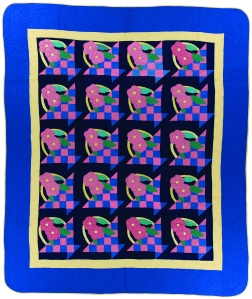Guest post by Janneken Smucker
Since the publication of Amish Quilts: Crafting an American Icon last fall, we’ve experienced a flurry of important exhibits and books about quilts. It’s no surprise that readers and museumgoers flock to these books and events. Quilts feel good. They bring on nostalgic feelings of warmth and family, even to those of us who did not grow up in a home full of quilts. That’s part of why quilts—whether antique art pieces, contemporary pieces produced by Amish cottage industries, modern art works, or factory made bedcovers—have long had such appeal.
One of the newest additions to the quilt reading list this fall is Roderick Kiracofe’s Unconventional and Unexpected: American Quilts Below the Radar 1950-2000, featuring selections from his collection of eclectic quilts, often produced from scraps and leftovers with surprising patterns, fabrics, and combinations. This has gotten me thinking about unconventional and unexpected Amish quilts. Ever since outsiders to Amish communities “discovered” these objects in the late 1960s and early 1970s, we’ve developed preconceived notions about what constitutes an Amish quilt, based on colors, patterns, and fabrics. As I explore in Amish Quilts, it’s actually quite challenging to pin down what is an Amish quilt because of the diversity among Amish settlements, the changes to Amish fashions over time, and the individual quiltmakers who liked to push boundaries and disregard conformity within their communities. For every supposed “rule” about what makes an Amish quilt Amish, there are many exceptions.
So, what makes an Amish quilt unconventional? It could be pattern, technique, colors, overall style, or even function. Some unconventional Amish quilts might actually be quite conventional to the rest of us; they just don’t fit what we expect from Amish quiltmakers. This is true of this cheery Basket of Flowers quilt, made by an unknown Amish maker who adapted a Mountain Mist pattern likely acquired by purchasing a roll of quilt batting—the soft inner layer of a quilt.

Basket of Flowers, unknown Amish maker, c. 1935. Possibly made in Ohio. International Quilt Study Center & Museum, University of Nebraska-Lincoln.
The pattern is quite conventional for the 1930s among the wider community of quiltmakers. But instead of the bubbly printed fabrics common to quilts of the Depression era, this Amish maker used the commercial pattern in a decidedly Amish setting, with black sashing and a wide outer blue border.
Other quilts we as outsiders might consider unconventional among the Amish may have in fact been quite conventional; they just did not fit the aesthetic of tastemakers who shaped the market for antique Amish quilts in the 1970s and 1980s. This is true of this blue and white sailboat quilt, as well as the many blue and white quilts—called “everyday” or “summer” quilts by some Amish—made since at least the 1920s in many Amish settlements.

Sailboat, unknown Amish maker, c. 1930-1950. Possibly made in Ohio. International Quilt Study Center & Museum, University of Nebraska-Lincoln.
Few collectors were interested in these light-colored quilts as they did not fit the aesthetic of those bedcoverings some Amish called “old dark quilts”—made from darker blues, purples, browns, and deep reds, which appealed to art collectors due to their resemblance to modern art.
Perhaps truly unconventional, at least among Amish quilts that have survived into museum collections, is the hap or comforter—a heavy utilitarian bedcover. Rarely did such objects come on the market, and more seldom still did a museum curator select one for a collection. But the unconventional and totally remarkable collection of Amish quilts at the Indiana State Museum, first acquired by David Pottinger, features not just quilts that look like abstract paintings, but any and every quilt Pottinger’s Amish neighbors in northern Indiana would sell him.

Nine Patch Four Patch, knotted comforter or “hap,” unknown Amish maker, LaGrange County, Indiana. From the collection of the Indiana State Museum and Historic Sites.
This hap is just one of many quilts in this collection that demonstrate the great diversity of Amish quiltmaking from just one geographic area.
The Amish indeed are a religious group that does many things strictly by tradition—by convention. But quilts made by individuals from this group can be quite unconventional, both by our standards and by theirs.
 Janneken Smucker is an assistant professor of history at West Chester University. A quiltmaker herself, she is author of Amish Quilts: Crafting an American Icon, now available from JHU Press.
Janneken Smucker is an assistant professor of history at West Chester University. A quiltmaker herself, she is author of Amish Quilts: Crafting an American Icon, now available from JHU Press.
To read The New York Times 2013 Holiday Gift Guide’s review of Amish Quilts, click here.


